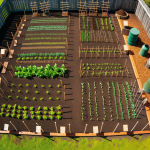Embrace the power of nature and transform your garden into a whimsical paradise with building a garden rockery. This captivating landscape feature offers a unique blend of natural beauty and creative design that will leave your guests in awe. By strategically arranging rocks of various sizes and shapes, you can create a stunning focal point that adds texture and depth to your outdoor space.
Not only does a garden rockery provide visual interest, but it also offers practical benefits. The rocks help to retain moisture in the soil, making it easier to maintain a healthy garden. They also create microclimates, providing shelter for delicate plants and attracting beneficial insects. With a bit of planning and creativity, you can build a rockery that seamlessly blends into your existing garden design and becomes a cherished element of your outdoor sanctuary.
Join us as we delve into the art of building a garden rockery, sharing expert tips and practical advice to help you create a truly enchanting space. Get ready to rock your garden and unleash its full potential!
What is a garden rockery?
A garden rockery, also known as a rock garden, is a carefully designed landscape feature that incorporates rocks of various sizes and shapes. It is a creative way to add visual interest and texture to your garden, creating a focal point that enhances the overall aesthetics of your outdoor space.
Garden rockeries have been around for centuries, with their origins dating back to ancient civilizations. They were often used to mimic natural rock formations and create miniature landscapes within larger gardens. Today, rockeries have evolved to suit various garden styles, from traditional to contemporary, and can be customized to reflect your personal taste and preferences.
The beauty of a garden rockery lies in its ability to blend seamlessly with the surrounding landscape. When properly designed, it appears as if the rocks have always been a part of the garden, enhancing its natural beauty and creating a harmonious balance between the man-made and the organic elements.
Benefits of building a garden rockery
Building a garden rockery offers numerous benefits for both the aesthetics and functionality of your outdoor space. Here are some key advantages:
1. Visual interest: A well-designed rockery adds depth, texture, and visual interest to your garden. The varying sizes, shapes, and colors of the rocks create a dynamic focal point that draws the eye and creates a sense of intrigue. Whether you choose to incorporate a small rockery as a standalone feature or create a larger rock garden, it will undoubtedly become a captivating element of your garden design.
2. Moisture retention: Rocks have the ability to retain moisture in the soil, which is especially beneficial in dry and arid climates. The rocks act as a natural barrier, preventing excessive evaporation and helping to maintain a more consistent soil moisture level. This can significantly reduce the need for frequent watering and make it easier to establish and grow a wide variety of plants, including those that thrive in drier conditions.
3. Microclimates and plant diversity: A garden rockery creates microclimates within your garden, offering sheltered areas that are perfect for growing delicate plants. The rocks provide shade, protection from wind, and insulation, creating different microenvironments that can support a diverse range of plant species. This opens up a world of possibilities for incorporating unique and rare plants that wouldn’t otherwise thrive in your garden.
4. Attracting beneficial insects: Rocks in a garden rockery create crevices, cracks, and creases that attract beneficial insects such as bees, butterflies, and ladybugs. These insects play a vital role in pollination and natural pest control, helping to keep your garden healthy and thriving. By providing them with a habitat, you’ll be encouraging a balanced ecosystem and enjoying the beauty of these fascinating creatures.
5. Low maintenance: Once established, a garden rockery requires minimal maintenance compared to other garden features. The rocks act as a natural weed barrier, reducing the need for constant weeding. They also help to regulate soil temperature, preventing extreme fluctuations that can stress plants. With proper planning and plant selection, you can create a rockery that thrives with minimal effort, allowing you to spend more time enjoying your garden.
Planning your garden rockery
Building a garden rockery requires careful planning to ensure a successful and visually pleasing result. Here are the key steps to consider when planning your rockery:
1. Evaluate your garden: Start by assessing your garden and identifying the ideal location for your rockery. Consider factors such as sunlight exposure, soil conditions, and existing garden features. Choose a spot that complements the overall design of your garden and allows for easy access and visibility.
2. Define the size and shape: Determine the size and shape of your rockery based on the available space and your desired aesthetic. A small rockery can serve as a focal point, while a larger rock garden can become a prominent feature within your garden. Sketch out a rough design to visualize how the rockery will fit into your existing landscape.
3. Research rock types: Research the types of rocks that are commonly used in garden rockeries and consider the geological characteristics of your area. Look for rocks that are native to your region, as they will blend more naturally with the surroundings. Consider the colors, textures, and sizes of the rocks, keeping in mind the overall theme and style you want to achieve.
4. Consider plant selection: Think about the types of plants that will complement your rockery. Choose plants that are well-suited to the microclimates created by the rocks, taking into account factors such as sunlight exposure, soil moisture, and drainage. Aim for a mix of colors, textures, and heights to create a visually appealing composition.
5. Create a budget: Determine your budget for building the rockery, including the cost of rocks, plants, soil, and any additional features. Consider whether you’ll need professional help for excavation and installation, or if you’ll be able to tackle the project yourself. Having a clear budget in mind will help you make informed decisions and avoid overspending.
6. Gather necessary materials: Once you have a plan in place, gather all the necessary materials, including rocks, soil, plants, and tools. Make a list of everything you’ll need, and ensure that you have easy access to these materials before you begin the construction process.
(Continued in next message…)
Choosing the right rocks for your garden rockery
Creating a stunning garden rockery starts with careful planning. Before you start gathering rocks or digging, take some time to consider the layout and design of your rockery. Assess the available space in your garden and determine the ideal location for your rockery. Consider factors such as sunlight, drainage, and access. You want to choose an area that will showcase your rockery while harmonizing with the rest of your garden.
Next, think about the overall style and theme you want to achieve. Are you aiming for a natural, rustic look or a more modern, minimalist design? Research different rockery styles and gather inspiration from magazines, online resources, and even other gardens. Create a rough sketch or use design software to visualize your rockery. This will help you determine the size, shape, and placement of the rocks.
Once you have a clear vision of your rockery, it’s time to start gathering the necessary materials. Take measurements of your chosen area and calculate the amount of rocks and soil you’ll need. Consider the weight of the rocks and ensure that your garden can support them. If you’re unsure, consult a professional landscaper or structural engineer for advice.
Preparing the area for your garden rockery
The choice of rocks is crucial to the success of your garden rockery. Not all rocks are created equal, and each type has its own unique characteristics that can enhance or detract from your design. When selecting rocks, consider their size, shape, color, and texture. Aim for a variety of sizes to create visual interest, and choose rocks with interesting shapes and textures that will add depth and dimension to your rockery.
One popular option for garden rockeries is limestone. Limestone rocks are readily available and come in a range of colors, from white and gray to warm earth tones. They are relatively easy to work with and can be stacked or arranged in various ways. Another option is sandstone, which offers a more natural and rugged look. Sandstone rocks come in a range of sizes and colors, and they add a touch of rustic charm to any garden.
If you’re looking for a more exotic look, consider volcanic rocks or granite. Volcanic rocks, such as basalt or lava rocks, are dark in color and have a rough texture that adds drama to your rockery. Granite rocks, on the other hand, are known for their durability and come in a variety of colors, including pink, gray, and black. Whichever type of rock you choose, make sure it suits your overall design and complements the existing elements in your garden.
Building the structure of your garden rockery
Before you start building your rockery, it’s important to prepare the area properly. Begin by clearing away any existing vegetation, weeds, or debris. This will provide a clean canvas for your rockery and prevent unwanted vegetation from competing with your plants. Use a shovel or a garden rake to remove any grass, roots, or rocks.
Next, assess the soil in your chosen area. Rocks and proper soil preparation go hand in hand. Most rockery plants prefer well-draining soil, so if your soil is heavy or compacted, you may need to improve its drainage. Add organic matter, such as compost or well-rotted manure, to improve the soil structure and fertility. If necessary, consider amending the soil with sand or gravel to promote better drainage.
Once the area is clear and the soil is prepared, you can start marking out the boundaries of your rockery. Use a garden hose or rope to outline the shape and size of your rockery. Take your time to ensure that the layout is visually pleasing and harmonizes with the surrounding garden. Adjust the position and shape of the boundaries until you are satisfied with the overall design.
Selecting and planting rockery plants
With the area prepared, it’s time to start building the structure of your garden rockery. Begin by placing the largest rocks as the foundation. These rocks will form the backbone of your rockery and provide stability. Dig a shallow trench to accommodate the rocks, ensuring that they sit firmly in place.
As you build up the layers, consider the natural flow and arrangement of the rocks. Avoid placing rocks in a uniform or symmetrical pattern, as this can look artificial. Instead, aim for a more organic and random arrangement that mimics nature. Vary the height, angle, and orientation of the rocks to create visual interest and depth.
As you work, take a step back regularly to assess the overall balance and composition of your rockery. Make adjustments as needed until you achieve a visually pleasing arrangement. Remember that building a rockery is an iterative process, and it may take some trial and error to find the perfect balance.
Maintaining and caring for your garden rockery
Once the structure of your rockery is in place, it’s time to select and plant the rockery plants. Consider the overall theme and style of your rockery when choosing plants. Opt for plants that thrive in rock crevices or have shallow root systems, as these are well-suited to the rocky environment. Alpine plants, succulents, and drought-tolerant perennials are popular choices for rockeries.
When planting, create pockets or crevices between the rocks where the plants can root. Add a layer of well-draining soil or gravel to each pocket and gently press the plants into place. Be mindful of the plant’s individual needs and provide adequate spacing to allow for growth.
Remember to choose plants that will complement the colors and textures of the rocks. Consider the height and spread of each plant to ensure a harmonious arrangement. Group plants with similar water and sunlight requirements together for easier maintenance.
Enhancing your garden rockery with additional features
To keep your garden rockery looking its best, regular maintenance is essential. Here are some tips to help you care for your rockery:
1. Watering: Rockery plants often have low water requirements, but they still need regular watering, especially during dry spells. Use a watering can or a drip irrigation system to deliver water directly to the base of the plants, avoiding the rocks.
2. Weeding: Keep an eye out for weeds and remove them promptly to prevent them from competing with your plants for nutrients and water.
3. Pruning: Trim back any dead or overgrown foliage to maintain the shape and appearance of your rockery. Be careful not to damage the rocks or nearby plants.
4. Fertilizing: Rockery plants generally don’t require heavy fertilization, but a light application of a balanced fertilizer in spring can help promote healthy growth.
5. Pest control: Monitor your rockery for any signs of pests or diseases. Treat any issues promptly to prevent them from spreading to other plants.
Conclusion
To take your garden rockery to the next level, consider adding some additional features that will enhance its beauty and functionality. Here are a few ideas to get you started:
1. Water feature: Install a small waterfall or a bubbling rock fountain to create a soothing and tranquil atmosphere in your rockery.
2. Lighting: Add some outdoor lighting to highlight the rocks and plants in your rockery. Solar-powered lights are a great option for a sustainable and low-maintenance solution.
3. Pathways: Create winding pathways or stepping stones that lead through your rockery, inviting guests to explore its hidden beauty.
4. Seating area: Install a bench or some comfortable chairs near your rockery, providing a cozy spot to relax and enjoy the view.
5. Sculptures or ornaments: Add some artistic elements, such as sculptures or ornaments, to inject personality and whimsy into your rockery.
By incorporating these additional features, you can create a truly enchanting space that will delight both you and your guests.





Thank you for your sharing. I am worried that I lack creative ideas. It is your article that makes me full of hope. Thank you. But, I have a question, can you help me?
Your article helped me a lot, is there any more related content? Thanks!